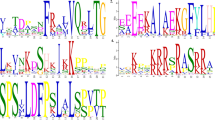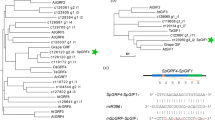Abstract
In this paper we describe the isolation and characterization of a genomic clone (Bp4) from Brassica napus which contains three members of a pollen-specific multigene family. This family is composed of 10 to 15 closely related genes which are expressed in early stages of microspore development. The complete nucleotide sequence of the clone Bp4 and of three homologous cDNA clones is reported. One of the genes (Bp4B) contained in the genomic clone is believed to be non-functional because of sequence rearrangements in its 5′ region and intron splicing sites. The remaining genes (Bp4A and Bp4C), as well as the cDNA clones, appear to code for small proteins of unique structure. Three different types of proteins can be predicted as a result of the deletion of carboxy or amino terminal portions of a conserved core protein. These proteins all share a common alternation of hydrophobic and hydrophilic domains. A fragment of the genomic clone containing the gene Bp4A, as well as the non-functional gene Bp4B, was introduced into tobacco plants via Agrobacterium-mediated transformation. The functional gene Bp4A is expressed in transgenic tobacco plants and shows spatial and temporal regulation consistent with the expression patterns seen in Brassica napus.
Similar content being viewed by others
References
Benfey PN, Chua N-H: Regulated genes in transgenic plants. Science 244: 174–181 (1989).
Bevan M: Binary Agrobacterium vectors for plant transformation. Nucl Acids Res 12: 8711–8721 (1984).
Brown JWS: A catalogue of splice junction and putative branch point sequences from plant introns. Nucl Acids Res 14: 9549–9559 (1986).
Brown SM, Crouch ML: Characterization of a gene family abundantly expressed in Oenothera organensis pollen that shows sequence similarity to polygalacturonase. Plant Cell 2: 263–274 (1990).
Chen EY, Seeburg PH: Supercoil sequencing: a fast and simple method for sequencing plasmid DNA. DNA 4: 165–170 (1985).
Chen Z-L, Schuler MA, Beachy RN: Functional analysis of regulatory elements in a plant embryo-specific gene. Proc Natl Acad Sci USA 83: 8560–8564 (1986).
Fabijanski S, Matlashewski GJ, Altosaar I: Characterization of developing oat seed mRNA: evidence for many globulin mRNAs. Plant Mol Biol 4: 205–210 (1985).
Frankis R, Mascarenhas JP: Messenger RNA in the ungerminated pollen grain: a direct demonstration of its presence. Ann Bot 45: 595–599 (1980).
Goldberg RB: Plants: novel developmental processes. Science 240: 1460–1467 (1988).
Gubler U, Hoffmann BJ: A simple and very efficient method for generating cDNA libraries. Gene 25: 263–269 (1983).
Halford NG, Forde J, Shewry PR, Kreis M: Functional analysis of the upstream regions of a silent and an expressed member of a family of wheat seed protein genes in transgenic tobacco. Plant Sci 62: 207–216 (1989).
Hamlyn PH, Gait MJ, Milstein C: Complete sequence of an immunoglobulin mRNA using specific priming and the dideoxynucleotide method of RNA sequencing. Nucl Acids Res 9: 4485–4494 (1981).
Hanson DD, Hamilton DA, Travis JL, Bashe DM, Mascarenhas JP: Characterization of a pollen-specific cDNA clone from Zea mays and its expression. Plant Cell 1: 173–179 (1989).
Joshi CP: An inspection of the domain between putative TATA box and translational start site in 79 plant genes. Nucl Acids Res 15: 6643–6653 (1987).
Joshi CP: Putative polyadenylation signals in nuclear genes of higher plants: a compilation and analysis. Nucl Acids Res 15: 9627–9640 (1987).
Koncz C, Schell J: The promoter of TL-DNA gene 5 controls the tissue-specific expression of chimaeric genes carried by a novel type of Agrobacterium binary vector. Mol Gen Genet 204: 383–396 (1986).
Kozak M: Point mutations define a sequence flanking the AUG initiator codon that modulates translation by eukaryotic ribosomes. Cell 44: 283–292 (1986).
Kuhlemeier C, Cuozzo M, Green PJ, Goyvaerts E, Ward K, Chua N-H: Localization and conditional redundancy of regulatory elements in rbcS-3A, a pea gene encoding the small subunit of ribulose-bisphosphate carboxylase. Proc Natl Acad Sci USA 85: 4662–4666 (1988).
Kyte J, Doolittle RF: A Simple method for displaying the hydropathic character of a protein. J Mol Biol 157: 105–132 (1982).
Maniatis T, Fritsch EF, Sambrook J: Molecular Cloning: A Laboratory Manual. Cold Spring Harbor Laboratory, Cold Spring Harbor, NY (1982).
Mascarenhas JP: The biochemistry of angiosperm pollen development. Bot Rev 41: 259–314 (1975).
Mascarenhas JP: The male gametophyte of flowering plants. Plant Cell 1: 657–664 (1989).
Mascarenhas NT, Bashe D, Eisenberg A, Willing RP, Xiao C-M, Mascarenhas JP: Messenger RNAs in corn pollen and protein synthesis during germination and pollen tube growth. Theor Appl Genet 68: 323–326 (1984).
McCormick S, Smith A, Gasser C, Sachs K, Hinchee M, Horsch R, Fraley R: Identification of genes specifically expressed in reproductive organs of tomato. In: Nevins DJ, Jones RA (eds) Tomato Biotechnology, pp. 255–265. Alan R. Liss, New York (1987).
Pedersen S, Simonsen V, Loeschcke V: Overlap of gametophytic and sporophytic gene expression in barley. Theor Appl Genet 75: 200–206 (1987).
Robert LS, Donaldson PA, Ladaique C, Altosaar I, Arnison PG, Fabijanski SF: Antisense RNA inhibition of β-glucuronidase gene expression in transgenic tobacco plants. Plant Mol Biol 13: 399–409 (1989).
Sari Gorla M, Frova C, Binelli G, Ottaviano E: The extent of gametophytic-sporophytic gene expression in maize. Theor Appl Genet 72: 42–47 (1986).
Stinson JR, Eisenberg AJ, Willing RP, Pe ME, Hanson DD, Mascarenhas JP: Genes expressed in the male gametophyte of flowering plants and their isolation. Plant Physiol 83: 442–447 (1987).
Tanksley SD, Zamir D, Rick CM: Evidence for extensive overlap of sporophytic and gametophytic gene expression in Lycopersicon esculentum. Science 213: 453–455 (1981).
Twell D, Wing R, Yamaguchi J, McCormick S: Isolation and expression of an anther-specific gene from tomato. Mol Gen Genet 217: 240–245 (1989).
Ursin VM, Yamaguchi J, McCormick S: Gametophytic and sporophytic expression of anther-specific genes in developing tomato anthers. Plant Cell 1: 727–736 (1989).
van Tunen AJ, Koes RE, Spelt CE, van der Krol AR, Stuitje AR, Mol NM: Cloning of the two chalcone flavanone isomerase genes from Petunia hybrida: coordinate, light-regulated and differential expression of flavonoid genes. EMBO J 7: 1257–1263 (1988).
von Heijne G: Patterns of amino acids near signal-sequence cleavage sites. Eur J Biochem 133: 17–21 (1983).
Walker MD, Edlund T, Boulet AM, Rutter WJ: Cell-specific expression controlled by the 5′-flanking region of insulin and chymotrypsin genes. Nature 306: 557–561 (1983).
Willing RP, Mascarenhas JP: Analysis of the complexity and diversity of mRNAs from pollen and shoots of Tradescantia. Plant Physiol 75: 865–868 (1984).
Willing RP, Bashe D, Mascarenhas JP: An analysis of the quantity and diversity of messenger RNAs from pollen and shoots of Zea mays. Theor Appl Genet 75: 751–753 (1988).
Wing RA, Yamaguchi J, Larabell SK, Ursin VM, McCormick S: Molecular and genetic characterization of two pollen-expressed genes that have sequence similarity to pectate lyases of the plant pathogen Erwinia. Plant Mol Biol 14: 17–28 (1990).
Yanisch-Perron C, Vieira J, Messing J: Improved M13 phage cloning vectors and host strains: nucleotide sequences of the M13mp18 and pUC19 vectors. Gene 33: 103–119 (1985).
Author information
Authors and Affiliations
Rights and permissions
About this article
Cite this article
Albani, D., Robert, L.S., Donaldson, P.A. et al. Characterization of a pollen-specific gene family from Brassica napus which is activated during early microspore development. Plant Mol Biol 15, 605–622 (1990). https://doi.org/10.1007/BF00017835
Received:
Accepted:
Issue Date:
DOI: https://doi.org/10.1007/BF00017835




